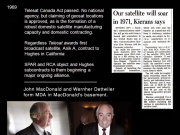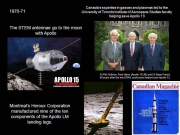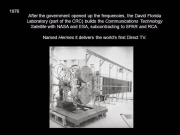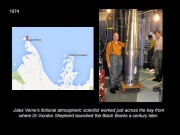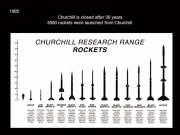100 Years of Aerospace History in Canada: From McCurdy to Hadfield Part 9 by Robert Godwin
From The Space Library
SPAR, Telesat, UTIAS rescues Apollo 13 and Churchill Expands but then Closes
In early 1968 SPAR became a publicly traded company. All of the contracts were transferred over to the new company from the SPAR division of DeHavilland. Dr Lapp was inevitably appointed to the Board of the new company while simultaneously taking on the role of President of CASI. During his tenure as President of CASI he presented Gerald Bull with the McCurdy Award for his work on big guns and the launching of so many of his Martlet payloads. At the ceremony Lapp dubbed Bull, "Sir Launchalot".[i] Bull's contribution rapidly diminished from this point forward. He left Canada and continued to work on large guns abroad until his assassination outside his apartment in Brussels in 1990.
The newly minted public version of SPAR elected to move into more varied fields of opportunity including diving equipment, emergency equipment, gearing, foam making, battery chargers (which evolved from the ISIS satellite program) and many other spin-off products.
During 1969 SPAR moved from Downsview to the Avro facility at Malton Ontario. Progress continued unabated with the ISIS program, and ISIS-1 was launched in January. Later that year the government put into effect their first full response to the Chapman Report in the form of the Telesat Canada Act which gave Canada a monopoly to provide satellite communications to Canadians.[ii]
The act also stipulated that Telesat must derive goods and services from Canadian industry; this was an attempt to fulfill the other recommendation of the SCC, that Canada should build a robust satellite construction industry.
In spite of this, Telesat chose to give the contract for Canada's first communication satellite, Anik-A, to the Hughes Aircraft Company in California. This led to a protracted and highly public debate wherein SPAR and RCA Canada lobbied to get this decision over-turned. The television publicity over this dispute ultimately led to Hughes Aircraft sub-contracting the space-frame and internal support structures to SPAR.
This decision evolved into a windfall for SPAR when Hughes management realized the capabilities of the SPAR team in the manufacturing arena. Soon a production line of Hughes satellites went into operation at SPAR. Anik-A would be launched in 1972 making Canada the first country to operate a geostationary domestic communications system.[iii]
Canada's work on atmospheric science and the University of Toronto's knowledge about gasses and plasmas was by this time almost unparalleled anywhere else in the world. This remarkable knowledge came to the forefront in one of the most unexpected ways in April 1970 when the Apollo management team contacted the University of Toronto Institute for Aerospace Studies (UTIAS) to ask for their help solving a problem with the incapacitated Apollo 13 spacecraft.
It was generally accepted that if you wanted someone to figure out what could or couldn't be expected to happen when gasses, and by extension explosives, expanded; you turned to the team at UTIAS led by Professor Ben Etkin. The UTIAS team was given a few hours to calculate what NASA could expect if they used the pressure in the tunnel to separate the Odyssey and Aquarius spacecrafts instead of the usual rockets. Etkin along with Doctors Phil Sullivan, Irving Glass, Rod Tennyson, Peter Hughes and Barry French provided the necessary calculations to help bring the crew safely home. Their efforts would not be recognized until forty years later when they received the Canadian Air & Space Pioneer Award.
The final ISIS top sounding satellite had been launched in 1971. It was the first built entirely by Canadian Industry.[iv] Later that year Canada's Communications Research Centre (formerly the DRTE) had begun work on a revolutionary communications satellite in conjunction with NASA and the ESA, called Communications Technology Satellite (CTS.) SPAR and RCA would again be contractors on the project. CTS would provide a new kind of direct communication for telemedicine and community television in remote areas. CTS would have a powerful transmitter allowing for much smaller receivers on the ground.[v]
It was launched in 1976 and renamed Hermes, becoming the world's first direct-to-home satellite TV relay. The technology was quickly adopted by public television in Ontario, British Columbia, Alberta and Saskatchewan. Special receiving stations were installed in remote communities to test the new system. Hermes would be the first satellite capable of being received by dishes as small as 0.6m and would lead to the Anik C and D series of broadcast satellites launched in the 1980s by the Space Shuttle.
Later in 1971 the United States government decreed that STEM was so important to American space goals that they listed it as a "strategic" piece of technology and ordered Raymond Engineering in the USA to reverse engineer it so that the USA wouldn't have to purchase STEMS from Canada. The only solution to this almost existential threat to Canada's top space company was to purchase an American company and license the technology to it. In 1972 SPAR acquired Astro Research Corporation of Santa Barbara California and STEM production for many American satellites left Canada. Ultimately this acquisition would impact the decision to give Astro the contract, many years later, to build the Mobile Transporter System for the International Space Station.[vi]
Throughout the 1970s the research continued unabated out of the Churchill range. The Canadian Centre for Space Science juggled budgets to keep the science teams in place. Dr Gordon Shepherd and others pursued hard scientific data in the ionosphere with an aggressive campaign of rocket launches. To be able to study events during solar eclipses the teams would have to establish launch sites in different locations.
In 1974 a decision was made to establish a launch site at Cape Parry in the Northwest Territories to study daytime aurora.[vii] In keeping with his apparent knack for predicting important space locations, this launch site was a mere 120 km away, straight across the bay, from where Jules Verne had sent his fictional astronomer/scientist in 1873.
Dr Shepherd was responsible for the Black Brant V launched from this location. Consistent with a multitude of other launches this rocket carried experiments from all across Canada including Shepherd's own home-base York University, as well as Environment Canada, the University of Saskatchewan and the National Research Council; which still represented the main oversight for these events.
The launches at Churchill, and elsewhere, demanded enormous effort from the small teams dispatched to these remote locations. Just a handful of men would prepare the payloads, assemble and fuel the launch vehicle, monitor the environment (often, as in the case of the Cape Parry launches, critical to the success of the experiment) and retrieve the data. These purely scientific space launches were soon to be overshadowed by the rebirth of American manned spaceflight which came in the form of the Space Shuttle program.
A few years later, when a new government came into office the National Research Council offered to close Churchill as part of the cutbacks proposed at that time. Shortly thereafter the rockets were silenced in Canada and the research moved south or west into Alaska.[viii]
Scientists throughout government and academic research facilities, including Shepherd, now turned their attention to creating experiments that might fly aboard the space shuttle. This new orbiting manned space laboratory offered entirely new opportunities throughout the aerospace community; a fact not missed by Phil Lapp and the team at SPAR.
Footnotes
[i] Ibid. Pg 184
[ii] Ibid. pg 198
[iii] Spacebound, Theodore Hartz, Irvine Paghis Minister Of Supply and Services, 1982
[iv] Ibid.
[v] Phil Lapp Memoir Pg 200
[vi] Ibid. Pg 203
[vii] Canada's 50 years in Space, Gordon Shepherd and Agnes Kruchio, Apogee Books, 2008
[viii] Ibid.
